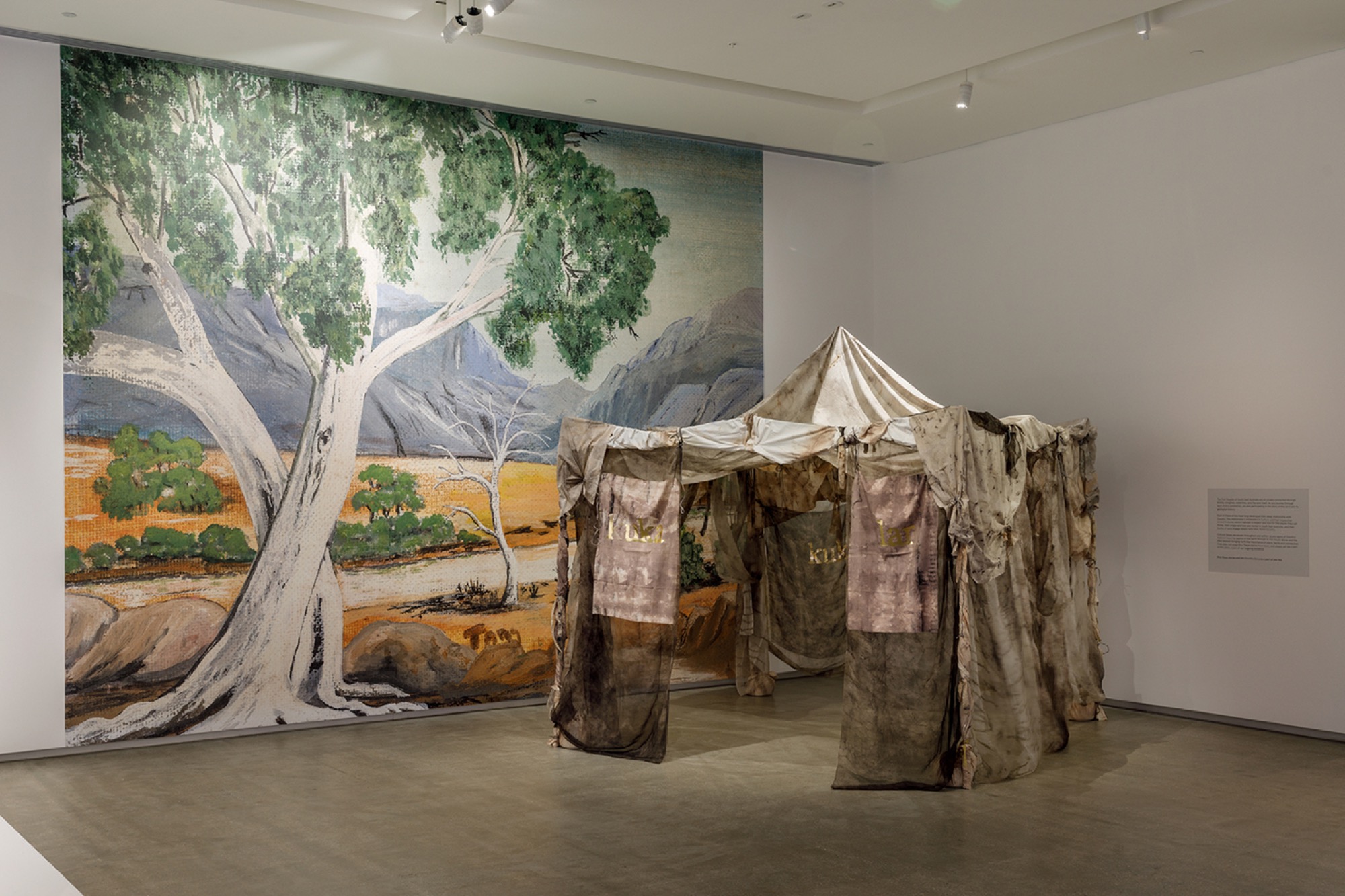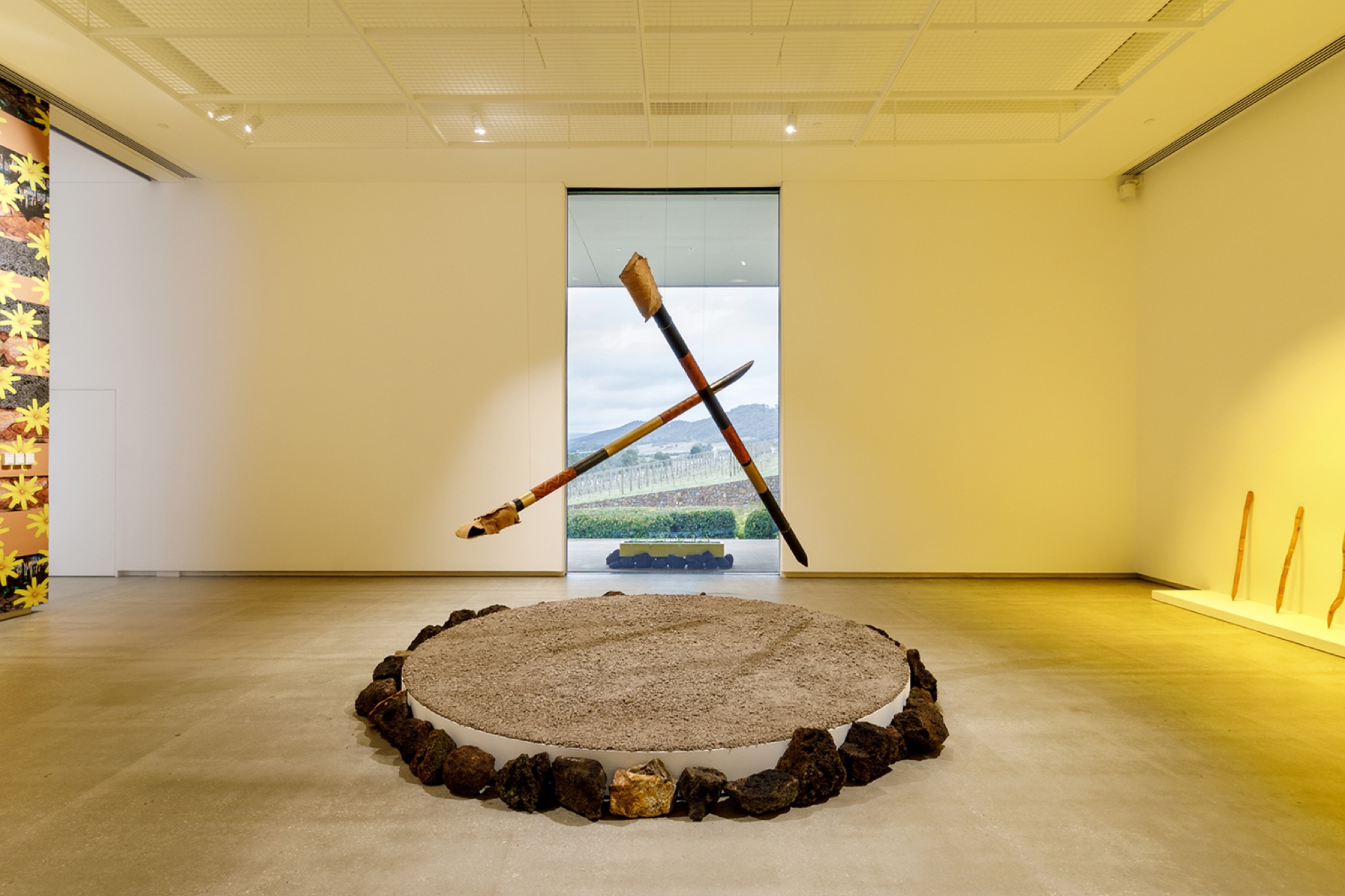
While WILAM BIIK is situated in a traditional gallery space, Wurundjeri, Dja Dja Wurrung and Ngurai Illum Wurrung curator Stacie Piper, ensures that story and community are the exhibition’s focus. In her preface to the show, Piper states that she sees her role as being a storyteller and story facilitator, “connecting past and present and allowing the continuity between them to show through.”
Piper achieves this in multiple ways, such as selecting First Nations artists from across the southeast to contest the colonial boundary of Victoria, disrupting space and landscape through curation. And addressing localised issues rather than popularised themes. As Murroona/Djiru educator and curator Kim Kruger articulated in a review of the exhibition, it is “a multi-layered conversation between Country, people and ancestors that surges with the power of Aboriginal connectivity”.

Blak curatorial decision making ensures that First Nations people’s cultural practices carryout far-reaching goals and artists’ intended meaning, which through colonisation and western framing have often been reduced to anthropological categorisation and interpretation. By challenging the western gaze in art and museology her vision also addresses the appropriation, fetishisation, tokenisation and/or trend of Blakness and activism rampant in contemporary art. It is a phenomenon that Yugambeh writer and academic Dr Maddee Clark warns us of in his essay The Crisis of De-colonising the Arts:
The art world appropriation of Blak aesthetics, lifeways, and languages without proper engagement with Blak people included, for Neika and I, the use of decolonisation as a visual rhetoric and a theoretical signifier. Arts organisations and institutions would utilise decolonisation as a buzzword without interrogating their own deeply held values or developing sincere relationships with First Nations people.
Piper’s curatorial decision making avoids the traps that Clark points out, while consciously subverting the limitations of the colonised space she works within at TarraWarra.

WILAM BIIK follows songlines, connecting artists beyond Victorian state boundaries, which are inscribed through colonisation. Kent Morris from Barkindji Country to Tyereelore and Trawoolway and Boonwurrung/Bunurong artist Nanette Shaw map First Nation connections prior to and beyond colonisation. Piper explains how connecting these artists is about a continuing culture that maintains itself through the an invasion that divided Country into settler territories marked with names like Victoria, New South Wales and Tasmania. She notes that “each of these artists have long developed their deep relationship with Country. This relationship is embedded in Culture and their respective Ancestral stories, which maintain a respect and love for the places they call Home”.
Piper adds further “the First Peoples of South East Australia are all closely connected through kinship, songlines, waterlines, and the land itself. As you journey through each artist’s installation, you are participating in the story of this land and its geological history”.

Throughout WILAM BIIK geographical context, or Home is conveyed as Country not as a circumscribed territory. When first entering the gallery you are struck by video projections of the Birrarung, created by the The Djirri Djirri Wurundjeri Women’s Dance Group. Their work Ceromony engulfs the otherwise white-walled space, severing the impact of colonisation. On screen, multiple generations of women continue dancing on their Country. We are reminded that this is not part of Victoria but is Wurundjeri country. A place which demands care and respect in order to repair from invasion.
In the long corridor parallel to the main gallery Nanette Shaw’s Kelp Vessel (2021) draws attention to the urgent need to mend her Country. She uses the same practice and materials that Tyereelore, Trawoolway Aboriginal women have done for thousands of years, to create a collection of traditional kelp water vessels. As you move along the corridor each delicate vessel becomes smaller in size, from the size of a large handbag to that of a delicate pouch, suggestive of the rapidly deteriorating coastal ecosystem in an era of climate crisis.

Repairing Country is a theme that evolved from place-based issues concerning Piper. As Kruger illuminated in her review “the vision for WILAM BIIK came from Piper’s sovereign responsibility to care for Country, and her despair at the unsustainable logging of old growth forest in the Warburton ranges not far from Tarrawarra on Wurundjeri biik”. Piper rejects the generic framing of climate change—reducing emissions, slowing down, the three R’s, etc—which too often fall into a reductive sameness rather than highlighting the distinctive needs and qualities occurring on different Country. WILAM BIIK helps understand the unique and intricate challenges occurring on Wurundjeri Country and other Country.
Jolene Rickard, a citizen of the Tuscarora nation, Turtle clan, who works as an artist, curator and visual historian wrote of her experience curating at the National Museum of the American Indian (NMAI)/Smithsonian Institution in 2002: “The NMAI’s presence simultaneously recognizes Indigenous survivance while underscoring our colonial subjugation”.

Issue No. 1
Grab a copy of Memo’s first glossy annual magazine issue, featuring an extended artist focus on Archie Moore, the 2024 Venice Biennale Australian Representative, with essays by Rex Butler, Tara Heffernan, Tristen Harwood, and Hilary Thurlow.
Issue 1 features articles by Audrey Schmidt, Philip Brophy, Helen Hughes, The Manhattan Art Review’s Sean Tatol, Cameron Hurst, Chelsea Hopper, among your favourite regular Memo contributors. There are reviews and articles, including on Melbourne design art, French literature’s ageing enfant terrible, Michel Houellebecq, Derek Jarman’s Blue (1993), the celebrated Spike magazine cultural critic, Dean Kissick, the local cult-favourite Jas H. Duke, and much, much more.
Memo Magazine, 256 pages, 16 x 25 cm

Similar problems face First Nations curators on this continent. The TarraWarra building follows western architecture’s aesthetic fascination with minimalist form, attempting to blend with and compliment the natural environment that it is built on. But by positioning the museum atop a rise in the landscape, the building directly overlooks the TarraWarra vineyards and a dam, a confected ‘environment’, celebrating the invasive uses of and changes to Wurundjeri biik since invasion. The building’s angles reiterate colonial changes to Country by highlighting their visibility with large windows. Highly aware of these constraints, Piper works against them in order to visualise her and other First Peoples sovereignty.
Koolyn, Gunnai, Djap Wurrung, Peek Wurrung, Dhauwurd Wurrung artist Arika Walu’s works Yuccan Noolert (Mother Possum) (2021) and Pun’Yin/Murnong (yam daisies) (2021) disrupts TarraWarra’s colonial interference with Country. Yuccan Noolert overrides the vineyards by placing the large-scale installation in front of the window. Walu’s culture is fortified by the placement of Pun’Yin / Murnong outside the window suggesting the potential for native plants to reclaim the vineyards.
Within the main gallery space Wemba Wemba and Gunditijmara artist Paola Balla creates a hidden sanctuary, asserting her sovereignty, which persists within the museum’s harshness. Murrup (Ghost) Weaving in Rosie Kuka Lar (Grandmother’s Camp) (2021) becomes a place to contemplate healing and the unconditional love of Country as a living entity. Balla explains:
I created this space to visualise healing from ongoing traumas, racism and the impacts of grief created by colonisation, to show what healing spaces could feel like, where restorative aesthetics, cultural acts and sovereign art weave across time. However, the capacity to express sovereignty does not erase trauma. Healing is not forgetting. Healing is not always forgiveness.

Her message is invaluable in the face of the contemporary art system, which continues to tokenise First Nation art, often clinging to flimsy forms of inclusion. Balla’s work addresses the architectural space and demands that First Peoples work is not reduced to trends. It offers First Peoples respite, while maintaining that healing and sovereignty are long processes and trauma not easily rectified.
Steven Rhall’s Of the Earth (2021) is an explicit attack on the architectural limitations in which art is usually contained. The multifaceted work destabilises the edifice of the building by physically breaking the gallery wall in order to show the work. It playfully asks that we disrespect spaces that have institutionalised First Nations culture, while asserting that culture has the capacity to identify and disrupt values demarcated by the art market. Clark writes in his review “WILAM BIIK shows a necessary breakdown of the authority of museums and other institutions to determine Aboriginal cultural practices. This breakdown is made physical in Taungurung artist Steven Rhall’s work— through the literal breaking down of one of the gallery walls.”.
Piper’s curatorial vision for WILAM BIIK engages with First Peoples through waterlines and bushlines, reinforcing the power of Blak people living contemporaneously with and on Country. Piper offers a view of First Nations cultural practice grounded in home and in doing so achieves what Rickard asserts:
The incorporation of expanded ideas of sovereignty in combination with contemporary analysis of Indigenous art has the potential to shift consciousness within Indigenous communities and surrounding colonial settler nations. Internally the recognition that WILIM BIIK expands our understanding of sovereignty in First Nations art, moving beyond what an exhibition is expected to achieve. It is a vital discussion point and document, which should be valued as a source within the current era of Treaty discussions, social and legal policymaking. The exhibition underscores that the artistic expression and cultural practices of Indigenous artists are fundamental tools required in any change-making processes occurring on this continent.